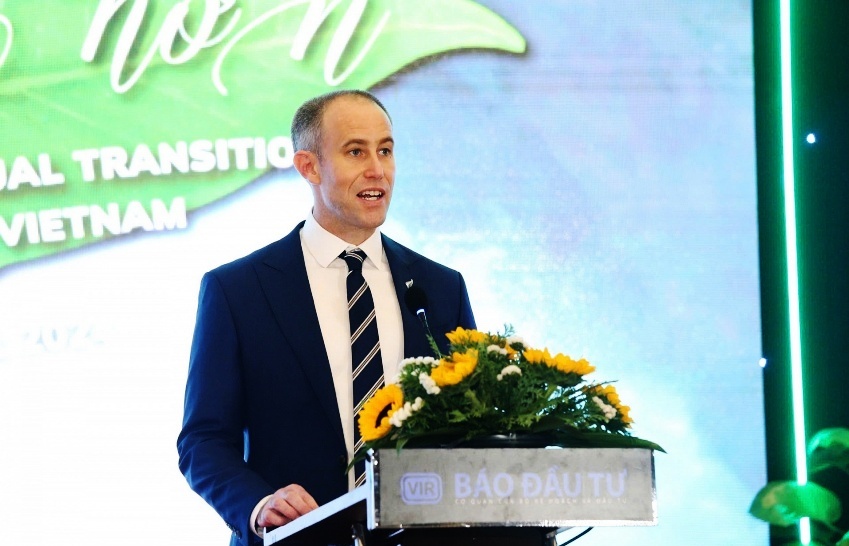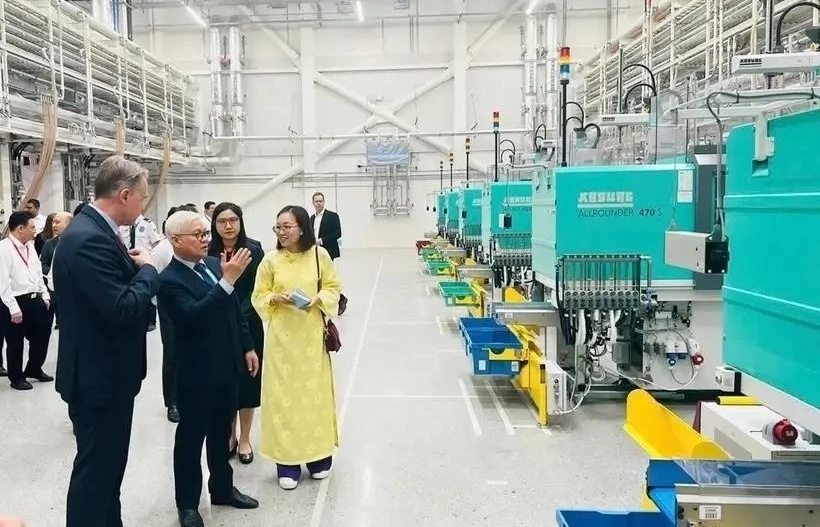Worker efficiency must make a leap
 |
| Poor productivity is one of the obstacles standing in the way of Vietnam’s growth goals Photo: Le Toan |
|
The Vietnam Development Forum 2017 (VDF) will take place on December 13 in Hanoi, with a key focus laid on the country’s productivity, which remains low. The VDF) – themed “Increasing productivity – the leverage for sustainable development” – will be attended by Prime Minister Nguyen Xuan Phuc and two deputy prime ministers, and be hosted by Minister of Planning and Investment Nguyen Chi Dung and World Bank Vietnam country director Ousmane Dione. The event is expected to be attended by about 350 delegates. VDF 2017, an official policy dialogue between the Vietnamese government and international development partners, will delve into impediments for increasing Vietnam’s low productivity, which has been undermining the country’s competiveness. The forum will also seek out specific solutions for improving the economy’s productivity, which will help the country to catch up with developed economies in the future, especially considering that the Vietnamese economy’s propellants like capital, labour, and natural resources have almost been maximised,” said a Ministry of Planning and Investment (MPI) document on VDF 2017. One day before VDF is organised, the Vietnam Business Forum 2017 will take place. This is an official policy dialogue between Vietnam’s government and the private business community. |
Japanese-backed plastic mould producer Senu Vietnam, based in the northern province of Hai Duong, is currently busy with production to fulfil its orders for the remaining weeks of the year. In 2017, the firm’s orders have increased by 15 per cent compared to last year.
“The increase is due to many factors, but one of the main reasons is that we have improved our productivity. With higher productivity, we have been able to land more contracts,” said Senu representative Takashi Masumitsu.
He told VIR that in the past, every new worker, despite having graduated from vocational schools in Vietnam, had to learn how to hold a screwdriver and work a screw from scratch before being allowed to officially work on the production floor.
Workers’ skills improved this year as the firm has co-operated with vocational schools to ensure workers are educated according to its needs.
Senu Vietnam has several automated production lines, with each machine currently operated by only two workers instead of four as had been the case previously.
“Though our company’s productivity is improved, it is still relatively low. Generally speaking, Vietnam’s labour productivity has gotten better, but remains sub-par. With the same production lines in Japan, we can produce 100 units of product per hour with only one worker, while the figure here is only 80 with two workers,” Masumitsu said.
Increased productivity
According to the International Labour Organization, labour productivity is an important economic indicator closely linked to growth, competitiveness, and living standards within an economy. It represents the total volume of output (measured in terms of GDP) produced per unit of labour (measured in terms of the number of employed persons) during a given time reference period.
The Ministry of Planning and Investment (MPI) reported that over the past few years, even though Vietnam has become a middle-income nation, the factors that have previously functioned as the economy’s driving forces, such as strong capital, intensive labour, and natural resources, are on the wane.
According to MPI, Vietnam is at risk of lagging behind other economies. As stated by the “Vietnam 2035” report – a joint Vietnam-World Bank study launched last year – it will take Vietnam 18 years with an average annual growth rate of at least 6 per cent to reach an average per-capita income equal to Malaysia’s 2010 number of $18,000. With an annual GDP growth rate of 7 per cent, Vietnam could hit South Korea’s 2003 average of $24,000 within seven years.
“This requires Vietnam to create a new growth impetus to boost its growth in a more sustainable manner,” said MPI Minister Nguyen Chi Dung. “Experiences from developed economies show that a rise in productivity is one of the key factors that can create sustainable development and breakthroughs for a nation. In Vietnam, productivity is increasing slowly, and if it is not boosted, the country will lag behind other nations.”
According to Masumitsu, Japan is a good example for productivity improvements. In the 1950s, the quality of products made in Japan was low. Based on research, Japanese experts designed models to increase labour productivity and the quality of products.
Businesses improved themselves according to the ‘five S’s’, which stand for the Japanese words seiri (tidiness), seiton (orderliness), seiso (cleanliness), seiketsu (standardisation), and shitsuke (discipline). These principles were applied radically in all production stages at Japanese firms.
“In Vietnam, workers’ quality has improved but needs to improve much more, and this is one of the key factors for Vietnam to attract more and more Japanese investments, and to keep its economic growth on the right track,” Masumitsu said.
Prime Minister Nguyen Xuan Phuc told the National Assembly last month that Vietnam’s growth has seen big improvements, with a strong growth rate for a long time, at 6.07 per cent annually in the 2011-2015 period. It is expected that the rate will be 6.7 per cent this year.
“The most positive indicator is that the economy’s labour productivity has risen, meaning the economic growth quality has improved,” Phuc stressed.
Specifically, labour productivity rose by 5.29 per cent last year and 5.87 per cent this year, while total-factor productivity (TFP) was 40.68 per cent last year and 44.13 per cent this year. The incremental capital-output ratio (ICOR) also decreased, at 6.41 per cent last year, and 6.27 per cent this year.
TFP is a measure of the efficiency of all inputs to a production process. Increases in TFP usually stem from technological innovations or improvements. Meanwhile, ICOR states how much additional capital is required to produce the next unit of production.
According to the General Statistics Office, labour productivity per capita was VND84.5 million ($3,840) last year, up 5.31 per cent against 2015. Compared to 2006, labour productivity rose by more than VND60 million ($2,727).
According to a survey on labour productivity and wage growth in Vietnam released two months ago by the Japan International Cooperation Agency and the Vietnam Institute for Economics and Policy, Vietnam’s labour productivity has risen by 4.4 per cent since 2004.
Mindset change
Resolution 5, issued in November 2016 by the 12th Party Central Committee, made increasing labour productivity one of the three pillars for achieving a new growth model for the country, in addition to growth quality and increased competitiveness. The resolution set a target of raising productivity by 5.5 per cent per year, and to have 30-35 per cent of enterprises engage in innovative activities every year in the 2016-2020 period.
At an April 2017 dialogue with workers in Vietnam’s central region, Prime Minister Phuc said that in order to boost productivity and encourage enterprises to apply high technology, the state has offered incentives regarding corporate income tax and personal income tax, as well as other favourable incentive plans.
“However, enterprises also need to use part of their profits for technological renovation. For example, Viettel has earmarked 10 per cent of its profit for renovation. I think we should also combine the state’s incentives with enterprises’ policies. This is imperative for raising labour productivity,” Phuc said. “Without investment in renovation, we cannot improve our productivity and competiveness.”
Vietnam National Productivity Institute director Nguyen Anh Tuan said that in order to boost labour productivity, the country must focus on three factors: capital, science and technology, and human resources.
“Vietnam is a developing country, so investment capital plays a key role in economic growth. The more focus we put on low-productivity sectors, the lower our economy’s labour productivity will remain. So investing more into advanced equipment and improving management skills is highly recommended,” Tuan said. “However, we should remember that to boost our labour productivity, it is also necessary to raise salaries for employees and give them better benefits.”
His company holds similar views, Senu’s Masumitsu said. Senu’s 800 employees have received better salaries and welfare.
“Vietnam’s business climate has improved significantly. If the government comes up with better
programmes on productivity improvement, companies like ours will perform better and contribute much more to the economy,” he said. “We will continue investing more in training, so each of the machines in our production chains can be operated by only one worker, as is the case in Japan.”
What the stars mean:
★ Poor ★ ★ Promising ★★★ Good ★★★★ Very good ★★★★★ Exceptional
Latest News
More News
- Vietnam on the verge of green industrial revolution (November 12, 2024 | 15:57)
- VIR sustainable development conference opens in Hanoi (November 12, 2024 | 09:42)
- Taking the lead in dual transition for a greener Vietnam (November 11, 2024 | 17:00)
- Vietnamese consumers careful amid economic volatility (November 11, 2024 | 13:55)
- Quality must come first in chip mission (November 11, 2024 | 10:33)
- Vietnam's digital economy estimated to reach $36 billion in 2024 (November 07, 2024 | 13:52)
- Authorities looks to tackle influx of cheap foreign goods (November 07, 2024 | 10:44)
- Trump claims 'magnificent' victory over Harris (November 06, 2024 | 16:55)
- Trump on verge of victory over Harris (November 06, 2024 | 14:26)
- Hanoi unveils innovative tourism event to celebrate cultural heritage (November 06, 2024 | 13:36)




















 Mobile Version
Mobile Version